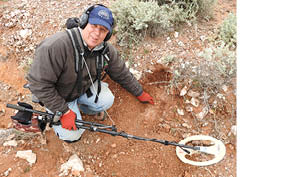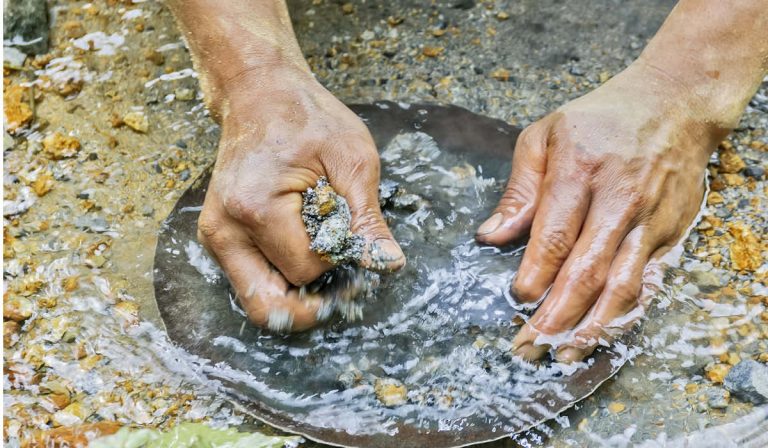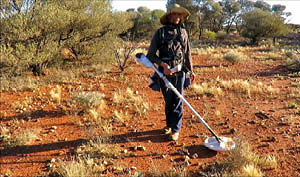The discovery of gold on Australian soil arguably hastened our development and population growth by as much as half a century, and is still a considerable export earner. Luckily for the traveller, gold can still be found through vast areas of Australia, and is still quite accessible, in small quantities, to the well-prepared enthusiast.
The media often reports on the discovery of very large nuggets. Last year a Victorian pensioner unearthed a 2 kg nugget just outside Bendigo. Worth up to $160 000 he named his find, “You wouldn’t believe it.” A girl walking her dog near Bendigo recently found a nugget worth $30 000, and another 1.4 kg chunk was unearthed over in Kalgoorlie, Western Australia. Going back a few years, the massive 24.6 kg Hand of Faith nugget was found in Kingover in 1980. The most famous gold chunk of all, the “Welcome Stranger,” first saw the light of day at Moliagul, Victoria in 1869, and weighed 65.3 kg.
Such finds are very unlikely, given the large number of people looking, but panning for alluvial gold, and getting out after small nuggets is a satisfying past time. It combines elements of bush travel, exercise and time outdoors, and if you throw in the drawcard of some historic locations and towns, it’s well worth the effort.
Clubs
Gold fossicking clubs are the best place to hook up with true enthusiasts. They have information nights and regular outings. Experienced members are always happy to help with the new chums.
I spoke to Paul, president of the Victorian Seekers Club, which has over two hundred members, mainly retirees, and asked him to highlight the benefits of club membership for Go55 readers.
“I often say to people that we are not only a prospecting club but also a caravan/camping club, a 4WD club and a social club. Our club camps in the golden triangle of Victoria for about five days most months. It is very social with “sundowners” most evenings, yarns around the camp fire and regular functions and games/competitions. Joining a club is also great because you are mixing with like-minded people who will help you get started. Gold detecting is much safer as part of a club rather than doing it alone. There are hazards in the gold fields and most clubs will have safety guidelines e.g. carrying a two-way radio, water, a GPS and detecting with someone else.”
“It sounds a little strange but if you only get into prospecting to find the next big gold nugget you probably won’t last too long. If you are after a long-term hobby and like the bush, camping and socializing with like-minded people join a club.”
Gold prospecting clubs in your area can be found with a quick internet search. Most also have Facebook pages, and these can be a great way of deciding whether or not a club is suitable for you before approaching them.
Where to find Gold
There are, of course, fossicking areas aimed at tourists, some of which even ‘plant’ gold for you to find. These are good places to learn the ropes as many will have panning experts available to show you the best techniques. Sovereign Hill at Ballarat is one example, and some historic gold towns hold special days and festivals at which such activities are staged as a one-off.
There are a number of recognised gold bearing areas in Australia. The biggest of these are Victoria’s “Golden Triangle,” Western Australia’s Goldfields region, Central Queensland, and the Bathurst area west of Sydney. South Australia and the Northern Territory have important commercial operations and some good fossicking prospects.
Only the most experienced prospectors go looking for new gold areas, usually in very remote areas. In the past, desperate and intrepid prospectors would go far ahead of settled areas, watching for tell-tale signs such as greenstone and quartz, panning every creek they came to, looking for the exciting yellow smear in the base of the dish. Lasseter’s “lost reef”, for example, has passed into Australian folklore.
Life is not quite that hard for the casual prospector these days. There are quite clearly defined gold bearing areas that declare their value well to the travelling gold hunter. The action is generally centred along certain rivers. Good finds still occur, as erosion and weathering constantly exposes new material to the surface.

Techniques
Gold is found in three basic forms: reef gold (veins in rocks), alluvial gold, and nuggets. Both of the latter types were originally formed from weathered reefs.
Reef gold is now generally the domain of serious mining operations delving from between 10 and 1000 metres below the surface, following the gold vein or leader. Much of the gold mined professionally these days is so small it is not even visible to the naked eye.
Alluvial and nugget gold is of most interest to the casual prospector.
Alluvial Gold
Alluvial gold is the cheapest and easiest target for prospectors, and your best chance at finding some colour. All you’ll need is a shovel, a plastic or iron gold pan, a bucket, and a gold-bearing creek and you should find your first specks of gold without too much effort.
The secret with alluvial gold is to remember that gold is the heaviest element. It will sink to the lowest point, and in water, slowly work its way to the bottom of lighter gravels. In strong flows it will be dragged along like other particles, but certain river bed formations work as traps, concentrating the gold particles.
Look for potholes, or just upstream of rock bars. Use your shovel or even a yabby pump to lift the deepest gravel from these areas into your bucket. Alternatively, in old gold mining areas, look for piles of spoil on the banks. This is gravel that has already been extracted by others, and is often worth panning, because there will still be flakes of gold that were missed.
As for the process of panning itself, an “Old Digger” described the process in the Melbourne Argus in 1894, and these instructions still apply today.
“All this material you have gathered you put into your bucket, and when it is full you take it and your tin dish to the bank of the creek for washing or “panning out.” Into the dish you put half your bucket of stuff and place it on the bank so that the water can wash into it. Now with both hands (the fingers open), commence to churn the stuff vigorously, breaking up the large lumps of clay and throwing out the stones as they come to the surface. Let plenty of water into the dish, but do not allow any of the material to escape out of it. After churning for a few minutes take the dish by the sides and give it a circular swirling motion, still letting the water into it. Churn again with your hands, throwing out the smaller stones. Repeat these processes until you have got down to about a handful of the stuff. Keep this at one end and lap in about a pint of water. Make this gently rotate round the dish, and it will gradually wash away the clay, leaving the black sand exposed, in which the gold, if any, will be seen. Don’t be disheartened if you should not come across a nugget first time. Think yourself lucky if you get a good “colour;” that is, half a dozen specks.”
Metal detectors
Whole books have been written on this topic, but the basic idea is that you outfit yourself with a metal detector, learn how to use it, locate an area where gold is likely to be found, get permission and permits if necessary and start looking. Most detectorists carry a small spade or pick. Be prepared for plenty of false alarms.
Different types of detectors will penetrate deeper than others, but the rule of thumb is that the bigger the nugget, the greater the depth at which the detector will locate it. Only a very large lump of gold will trigger an alert at more than thirty centimetres under the surface with most types of detectors.
I asked Paul from the Seekers Club to recommend an entry level detector, and he gave the following advice: “A company called Minelab manufactures a large range of metal detectors and are the most popular maker of gold detectors. Their products include a top-of-the-range gold detector (GPZ 7000) which will set you back close to $10 000. For less than half of this you can buy an SDC 2300 which is very simple to use and very good on small gold. The GPX 4000 / 4500 or 5000 are three very good detectors, with more settings and a range of coils for different conditions.”
He also says that while can take years to become truly proficient with a detector, early success can happen. “I bought a Minelab 2200D in 2004 and on my first detecting trip with it I was returning to my car and detecting along a fence line. Every now and then I would get too close to the wire fence and the detector would howl. On one occasion the detector made another large noise over a chunk of quartz poking out of the ground. I dug the quartz out and kicked it to the side but when I put the coil back over the hole there was no sound – it was not the fence which made my detector sound off. I picked up the quartz rock which was a bit larger than a softball and on close inspection there was gold right through it. I took it into a gold shop in Ballarat and the owner did some special tests and said I had close to 11 ounces of gold. In today’s money that would have been about $20 000 worth. I got a lot less than that, but it got me hooked.”
Permits and Requirements
Most states require that you purchase a Miner’s Right before you can prospect anywhere other than a special fossicking reserve. (Yes, that’s pretty much the same piece of paper that sparked the Eureka Stockade). In general this permit will allow you to search for gold on vacant crown land, a pastoral lease that is not covered by a granted mining tenement (with permission from the lease-holder), and a mining tenement, (providing you have permission from the tenement holder).
If you do not fulfil these requirements you may not have any right to possess the gold you find. Imagine if that happened with a once in a lifetime nugget! Once again, clubs are a great source of information on legal requirements in your state.
So what are your chances?
Gold was once one of the very few ways for a poor individual to become rich or at least attain a higher standard of living. In the mid-nineteenth century, up to a million people were actively prospecting for gold in Australia. In 1930, on the cusp of the great depression, the New South Wales mines department was instructing up to one thousand desperate people in prospecting skills and sending them off into the outback with a small subsidy.
So we all know that big gold mining corporations are still making money from huge open cut or shaft mines, but is there anything still out there, apart from the very rare huge nugget?
Paul answers this question with the following: “Gold is getting harder to find but enough good nuggets are still being found to give us hope. Metal detectors are also still improving so with the right equipment, a bit of hard work and a positive attitude, small sub-gram nuggets are often found by our club members. However, I would emphasize that most of our club members are not prospecting for financial reward.”
In other words, it’s not about the money, but getting outdoors and doing something interesting. That has to be more precious than gold, doesn’t it?
Greg Barron is a novelist and writer based in Northern New South Wales. You can read more of his work at StoriesofOz.com








11 Comments
Enjoyed your article planing on coming to Australia next year
That is just *not* a good description of panning. (Particularly, perhaps, with a modern, larger plastic pan like the Garret Super Sluice, which has riffles on one side.)
The description will give the impression to people that, after the churning, you just start swirling material around in your pan until the light stuff is out — which is not how you do it.
People should go to YouTube and look up some panning tutorial videos. There are plenty of good ones.
I’m glad you corrected the panning mistake coz that is DEFINITELY not how it’s done.It was a lazy way of panning.Good one for making a stance on this,well done…😊
I want to come to Australia and join a club that involves looking for gold. I live in UK. I hold a NZ passport. I would love to join a group.
You should come! I’d like to do a group thing also, it’s far safer, and more fun!
The thing with hunting gold is, it’s not all about the gold for me.. Your out camping, nights sky’s, camp fires good people and you get to see parts of Australia that MANY don’t..
I’m planning a week out in the Victorian High Country’s golden triangle for a quick covid escape- I’m going bush ranger lol they’ll never take me alive 😉
Come, bring a friend and enjoy the best of Australia, we would love to have you!
Hi
Does anyone live in sydney, I don’t have a car could anyone recommend where I can take public transport to gold panning or metal detecting. Please advice. Thankyou
To Elaine and Wayne (and everyone else)
I also have plans about going to Australia next year to detect gold. Should we make a Facebook-group so we can discuss how the matter ?
Send me and email to get things started p.g.h@live.dk or find me on Facebook: Peter Hansen Vordingborg Denmark.
Elaine: I have send you af friend request on Facebook. There was only one of you but 2 Waynes :).
Regards Peter
I wish I could find a way too join a club, I so want too try prospecting for gold, but as I’m on double crutches due too severe injuries, i feel like i miss out on things i so want too try doing, is there anything anyone can recommend in sydney for me too try gettimg into.some clubs I can get by on 1 crutch, I so want too try this as it’s been a long term passion along with astronomy .
Hi Hkan, I’m not sure where you live but here are some links that might hlep you https://www.victorianseekersclub.org.au/
https://www.prospectorspatch.com.au/getting-started/right-place-start/
https://pmav.org.au/
https://www.prospectingaustralia.com.au/forum/
https://www.goldindustrygroup.com.au/
I am very interested in gold hunting…I am from India and I like to see Australia for gold hunting….I saw many videos and I understand that if you are ready to do hard work then no one stop you to make golden man….if any chance of getting me there in Australia
Am from Uganda Africa and I wanted to join